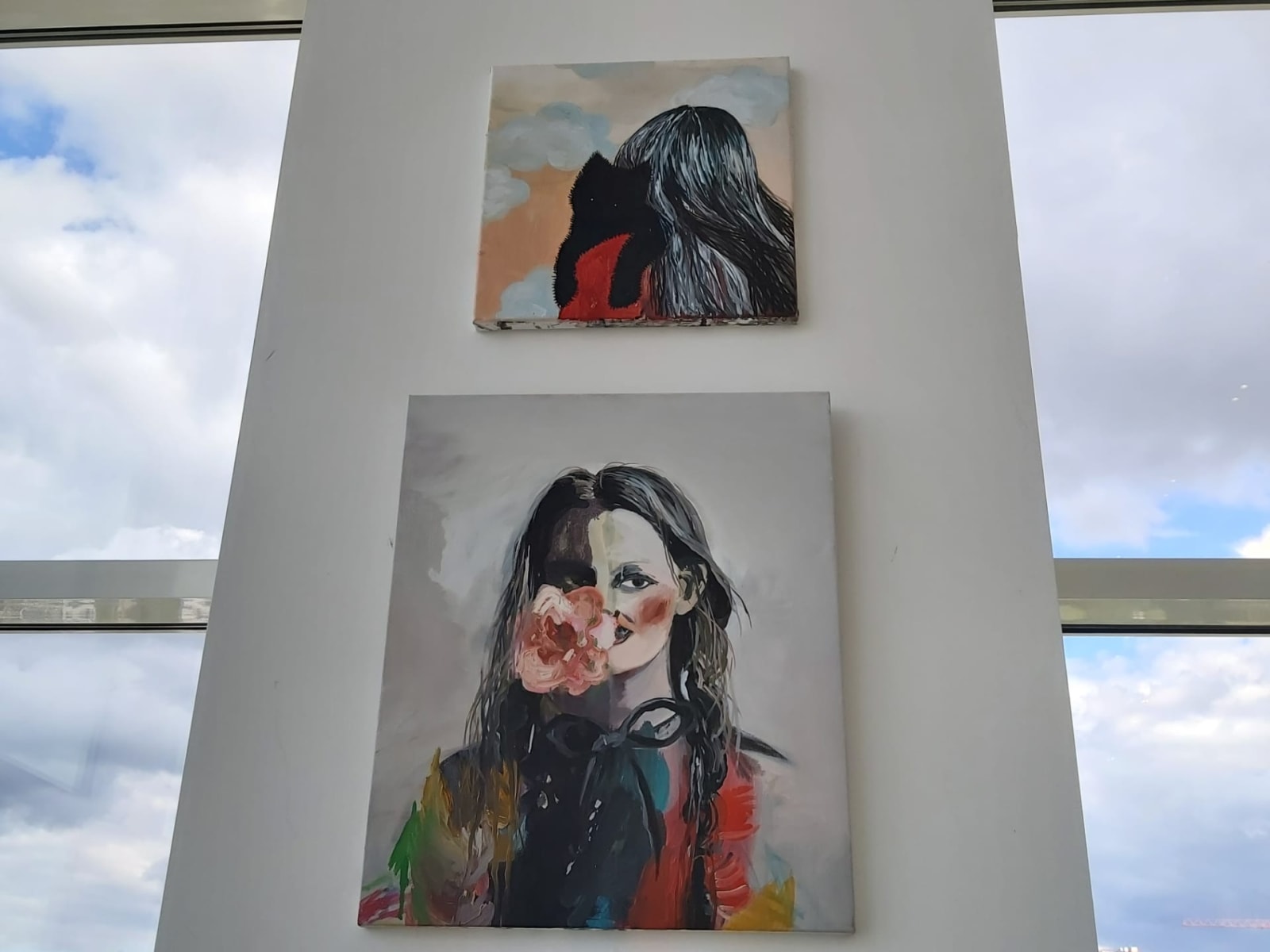藝術家訪談《新日常:漢娜・伊淇》: Interview
Current event
介紹
「不容易被看見的事物,我反而會去加強它。」–漢娜・伊淇
藝術使我們能夠審視作為人類的意義、使我們能夠跨距離的交流、使我們團結在一起。 2020年至今,我們面臨著全球疫情危機。另一個角度而言,自由的限制或許能成為藝術的再進化。這次,我們邀請國內外藝術家進行訪談,聊聊他們的「新日常」。
Q. 嗨 Hanna,妳的早晨儀式?
H. 嗨,謝謝你們的邀請!我喜歡早起,很享受早晨。它們對我來說是新的開始,感覺很多事情都有可能發生。 我特别喜歡 我會從一杯熱茶來開始我的一天。 端著杯子並好好享受寧靜。 之後就是運動和吃早餐,然後就開始準備去工作室:) 我的早晨通常很長,我很感激,因為作為一名自由職業者,我可以很從容地、慢慢地享受每一個的早晨。
Q. 妳如何渡過疫情?尤其是在布魯塞爾和波蘭?
H. 目前比利時和波蘭的一切都開放。幾乎感覺什麼都沒有發生過。過去的 1.5 年既艱難又似乎充滿希望。疫情剛開始的時候,我感到了很多的平靜和解脫,這是一件好事。突然之間,在城市裡無事可做,沒有碰面,沒有旅行。我開始專注於我的工作和家庭。但我很快意識到這種情況不會很快改變,這讓我感到很不舒服。我很擔心我的父母,因為他們住在波蘭,所以我們無法見面。
Q. 妳如何渡過疫情?尤其是在布魯塞爾和波蘭?
H. 目前比利時和波蘭的一切都開放。幾乎感覺什麼都沒有發生過。過去的 1.5 年既艱難又似乎充滿希望。疫情剛開始的時候,我感到了很多的平靜和解脫,這是一件好事。突然之間,在城市裡無事可做,沒有碰面,沒有旅行。我開始專注於我的工作和家庭。但我很快意識到這種情況不會很快改變,這讓我感到很不舒服。我很擔心我的父母,因為他們住在波蘭,所以我們無法見面。
我住在布魯塞爾的一個小公寓裡。我沒有任何花園或陽台,所以我每天必須去散步以保持清醒 我開始瘋狂工作。老實說,我覺得可以去工作室對我來說有很大幫助。
去年夏天,我在我父母在波蘭的家裡度過。他們有一個大花園,周圍是一片森林,非常與世隔絕。自從我 11 年前搬到比利時以來,這是我第一次在波蘭尼卡茲德羅伊渡過了 2.5 個月的時間。我非常享受在這裡的生活。所以我決定今年也這樣做。
與此同時,這段文字來自波蘭尼卡。我看到綠色,我聽到周圍的鳥鳴我確實認為,如果你住在城市或鄉村,疫情的經歷會有很大不同。對我來說,在這當下我會選擇在大自然中而不是在城市裡。
Q. 那是什麼人或事陪伴妳呢?
H. 很高興我能觀察我的貓 Cicia :) 她不知道世界上正在發生什麼,所以她的生活根本沒有改變。 這讓我覺得看待疫情的想法是非常相對的。 另外,我也散了很多步。 當我們經歷封城時,那是布魯塞爾的一個早春。 觀察大自然的成長和變化是非常令人欣慰的。
Q. 疫情如何影響到妳與人/事/物的關係?
H. 疫情期間,世界放緩,我也感覺到了。我認為疫情教會了我們要謙虛,沒有什麼可以永遠持續下去。 這就是我的感受。 它幫助我欣賞細節,放慢腳步並專注於現在,而不是計劃下一步。 此外,我開始種植室內植物。
Q. 妳近期的作品是否反映了這些變化?
H. 有的!我開始更仔細的觀察我周圍的事物。 我畫了一系列名為「在家」的作品。 我畫了我的貓 Cicia,我的植物。 在我散步的過程中,我拍了很多照片,它們是我的靈感來源。 我也畫了我所看到的風景。而現在,在波蘭,我深受大自然的啟發,我每天所見的花園、綠色、樹木。
Q. 封城增加了妳在工作室的時間。對妳而言是個好時光嗎?
H. 即使沒有疫情,我平時也花了很多時間在我的工作室或在家畫畫。 但確實在封城那段時間裡,我感到腦中有更多空間、更少分心、工作室更安靜、周圍的人更少。 我絕對可以更好、更高效地工作:)
Q. 周圍的寧靜是否讓妳感受到更強烈的光影與色彩?
H. 緩慢的生活確實以一種好的方式影響了我,我越來越關注光影。 我喜歡傍晚的光線,以及波蘭夏令裡的最後一縷陽光。 與過去相比,我發現我使用了更多的綠色,也嘗試了更多色彩的可能性。
Q. 妳如何將自然色彩轉化為妳繪畫的中的顏色?
H. 當你在觀看某個物件時,比如說一株植物,你可能會看到綠色的葉子、綠色的莖。 但如果你看得更近更久,你會開始注意到其他顏色、陰影、光、污點、不同綠色的嫩葉和老葉,也許上面還會有一些花紋。我經常轉換,不容易被看見的事物,我反而會去加強它。 我憑直覺繪畫,所以這個過程發生得很快。但是在畫畫之前,我確實會觀察我周圍的事物很長時間。
Q. 也就是說妳的藝術宇宙與周遭的世界直接連結。
H. 是的。 我畫我周圍看到的東西。 我經常將不同的圖像放在一件作品中。 我對繪畫的視覺呈現與其氛圍、感受都很感興趣。 這就是為什麼直覺在我的工作過程中起了重要作用。這大概就是為什麼我的作品可以用「夢幻」來形容,有一種超現實的感覺。 我喜歡剛起床時,釐清夢境與清醒之際的那一刻。 我也在工作中使用舊照片和我小時候的回憶。
Q. 在妳的生活中,是否有某個時刻似乎與現實背道而馳?
H. 我父母有一個花園,其中一部分是森林。 去年某個晚上,我們進去看螢火蟲。 當我們進入森林時,看到了非常多隻,那些小燈在我們四周飛舞。 天很黑,除了他們,你什麼也看不見。當時我就像處在宮崎駿的童話裡 。
Q. 妳近期的作品是否反映了這些變化?
H. 有的!我開始更仔細的觀察我周圍的事物。 我畫了一系列名為「在家」的作品。 我畫了我的貓 Cicia,我的植物。 在我散步的過程中,我拍了很多照片,它們是我的靈感來源。 我也畫了我所看到的風景。而現在,在波蘭,我深受大自然的啟發,我每天所見的花園、綠色、樹木。
Q. 封城增加了妳在工作室的時間。對妳而言是個好時光嗎?
H. 即使沒有疫情,我平時也花了很多時間在我的工作室或在家畫畫。 但確實在封城那段時間裡,我感到腦中有更多空間、更少分心、工作室更安靜、周圍的人更少。 我絕對可以更好、更高效地工作:)
Q. 周圍的寧靜是否讓妳感受到更強烈的光影與色彩?
H. 緩慢的生活確實以一種好的方式影響了我,我越來越關注光影。 我喜歡傍晚的光線,以及波蘭夏令裡的最後一縷陽光。 與過去相比,我發現我使用了更多的綠色,也嘗試了更多色彩的可能性。
Q. 妳如何將自然色彩轉化為妳繪畫的中的顏色?
H. 當你在觀看某個物件時,比如說一株植物,你可能會看到綠色的葉子、綠色的莖。 但如果你看得更近更久,你會開始注意到其他顏色、陰影、光、污點、不同綠色的嫩葉和老葉,也許上面還會有一些花紋。我經常轉換,不容易被看見的事物,我反而會去加強它。 我憑直覺繪畫,所以這個過程發生得很快。但是在畫畫之前,我確實會觀察我周圍的事物很長時間。
Q. 也就是說妳的藝術宇宙與周遭的世界直接連結。
H. 是的。 我畫我周圍看到的東西。 我經常將不同的圖像放在一件作品中。 我對繪畫的視覺呈現與其氛圍、感受都很感興趣。 這就是為什麼直覺在我的工作過程中起了重要作用。這大概就是為什麼我的作品可以用「夢幻」來形容,有一種超現實的感覺。 我喜歡剛起床時,釐清夢境與清醒之際的那一刻。 我也在工作中使用舊照片和我小時候的回憶。
Q. 在妳的生活中,是否有某個時刻似乎與現實背道而馳?
H. 我父母有一個花園,其中一部分是森林。 去年某個晚上,我們進去看螢火蟲。 當我們進入森林時,看到了非常多隻,那些小燈在我們四周飛舞。 天很黑,除了他們,你什麼也看不見。當時我就像處在宮崎駿的童話裡 。
Q. 妳認為好的藝術都應該邀請我們以不同的方式看待世界嗎?
H. 我認同。我認為任何形式的藝術都會讓我們以不同的方式看待世界。 好的作品,更確切地說,會留在我們的腦海中的作品,是能與我們對話的作品、能為我們的生活增添一些東西。
Q. 最後,妳最喜歡的兒時回憶?
H. 3歲那年,我第一次去海邊。 我看到了海灘,我躺下,開始在沙灘上移動我的腿和手臂。 我很高興也很驚訝有這麼大的沙坑。 這是一個無限的遊樂場:) 我簡直不敢相信這樣的東西會存在。
H. 我認同。我認為任何形式的藝術都會讓我們以不同的方式看待世界。 好的作品,更確切地說,會留在我們的腦海中的作品,是能與我們對話的作品、能為我們的生活增添一些東西。
Q. 最後,妳最喜歡的兒時回憶?
H. 3歲那年,我第一次去海邊。 我看到了海灘,我躺下,開始在沙灘上移動我的腿和手臂。 我很高興也很驚訝有這麼大的沙坑。 這是一個無限的遊樂場:) 我簡直不敢相信這樣的東西會存在。
我喜歡這種記憶,因為它展示了一個孩子第一次經歷某事的純粹快樂。







